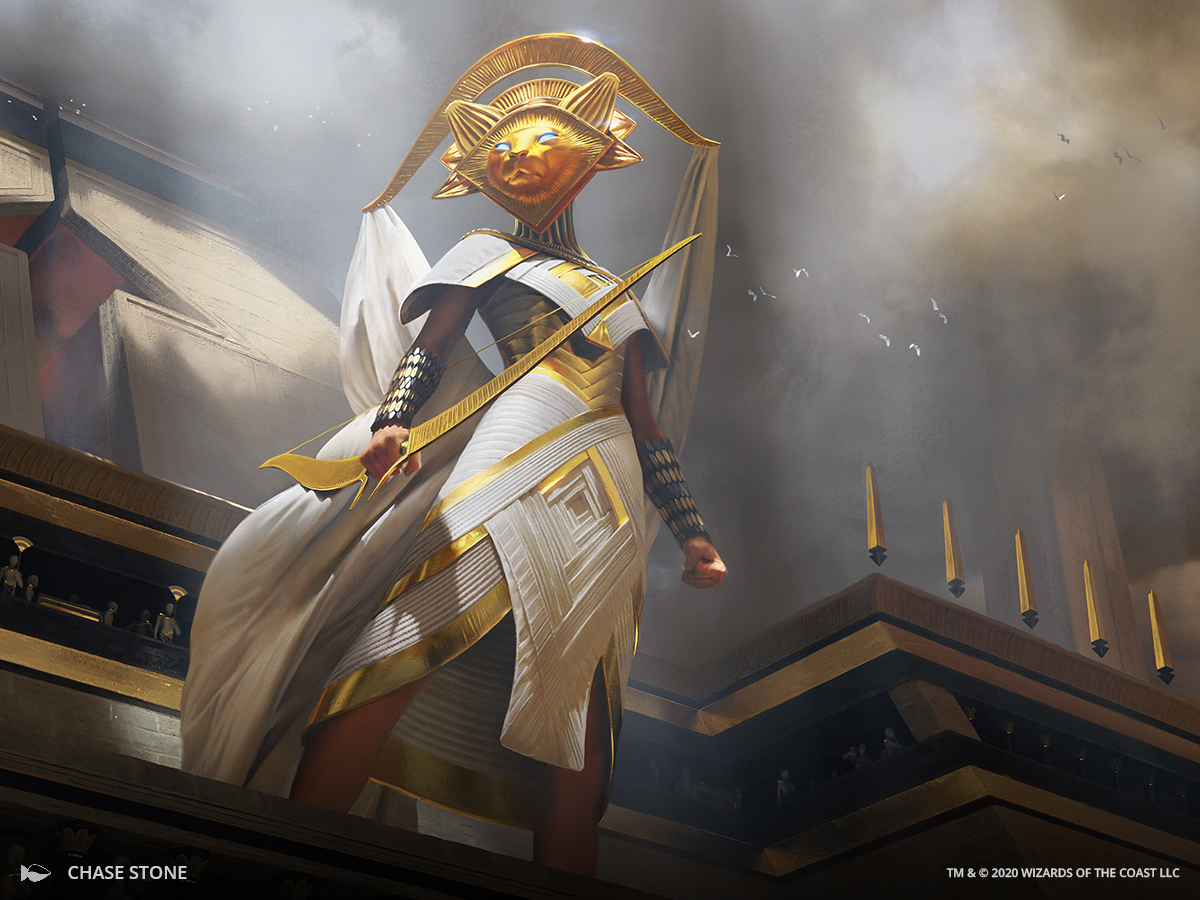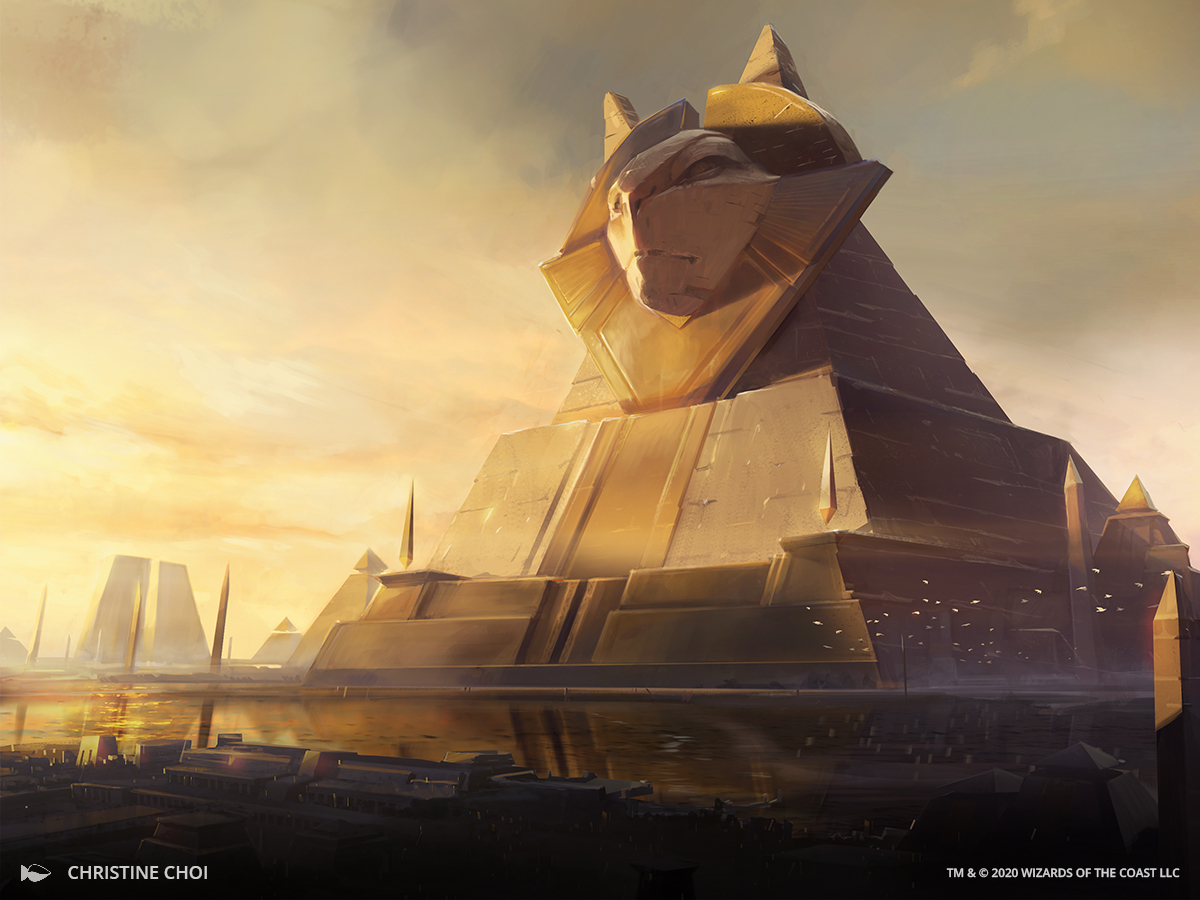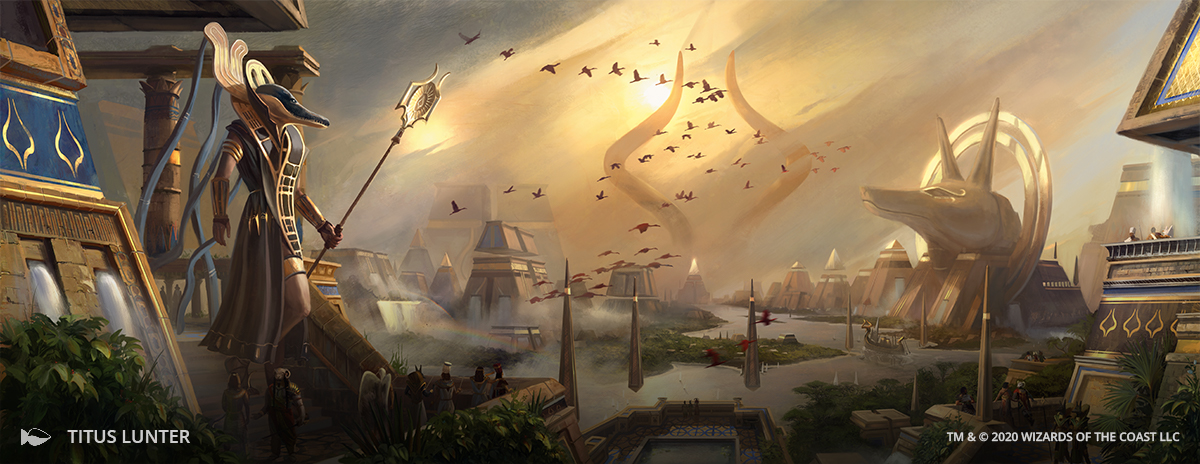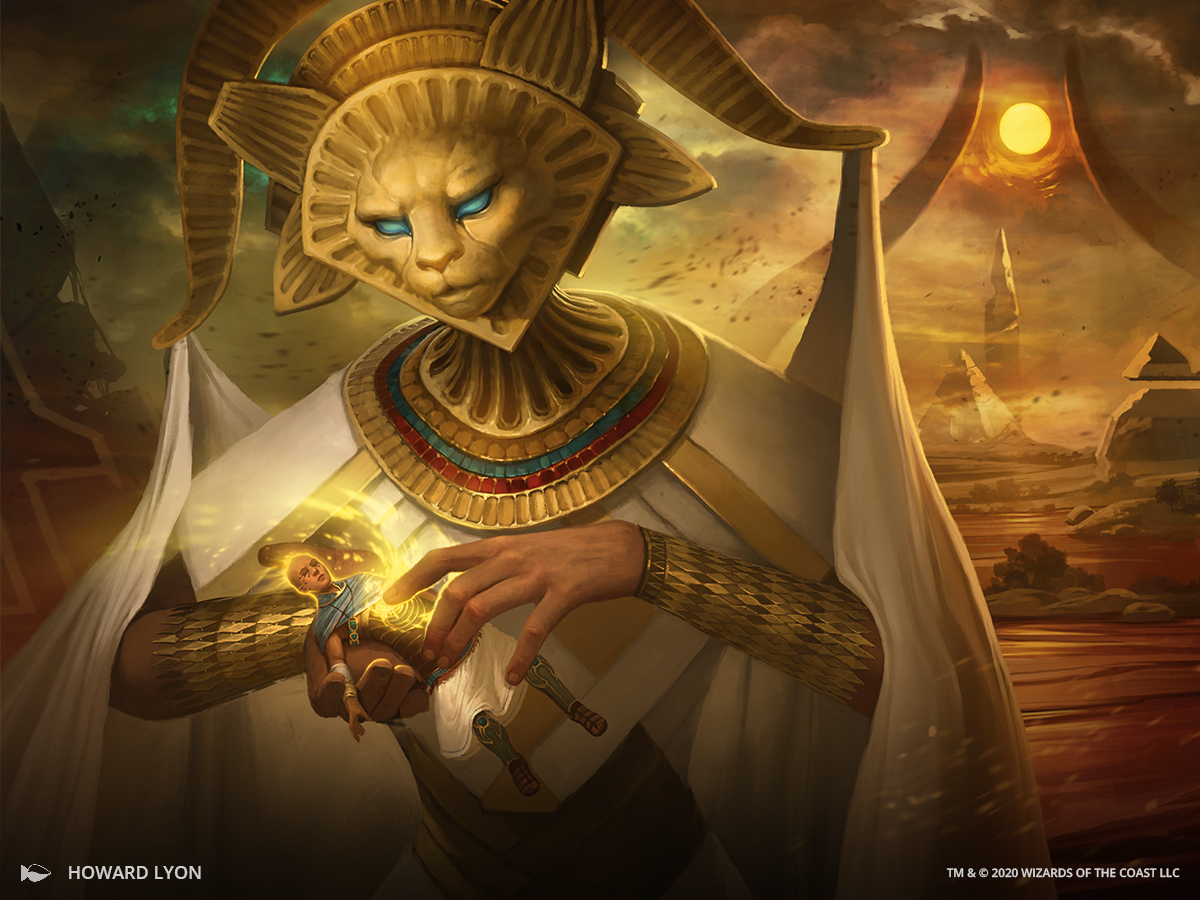Creating Basri Ket
Check out Mark Rosewater's Basri Ket preview article here.
I'm Liz Leo, the creative producer for the Wizards Franchise Development Team, and today I'm going to be bringing together some of the key creatives in the development of Magic's newest Planeswalker to give us a rundown on everything we need to know about Basri Ket.
We are often tasked with creating a Planeswalker to fully inhabit and represent a certain world. You've most recently seen the introduction of Lukka into Ikoria, who is bonded to the set's worldbuilding across his costume, powers, and story. But what happens when the ask is to design a Planeswalker for a card set that is not connected to a single plane? Core Sets are the perfect places to introduce characters that haven't intersected with our main storyline yet and set them up to play a part in the future of Magic.
For Core Set 2021 (M21), we developed Basri Ket to bring a fresh face to the Core Set. I have gathered Senior Narrative Designer Gerritt Turner, Senior Art Director Daniel Ketchum, and Game Designer Sydney Adams to answer some questions about the process of bringing Basri into being.

Q: Let's start with learning about who Basri is. Can you talk about the genesis of the character and dive a bit into his backstory?
Daniel Ketchum: When we were tapped to create a new white-aligned paladin, we brainstormed a number of concepts—some of which may eventually also see the light of day! But ultimately, we thought Basri Ket best met the ask. Basri is a paladin in the truest sense, duty sworn to an ideal, making him approachable to players who are new to Magic but familiar with fantasy tropes. But the details we've used to flesh out Basri put a twist on those tropes and will be rewarding for longtime fans, all while perfectly embodying the tenets of white's slice of the Magic color pie: protection, order, and banding together to achieve a common good.
Gerritt Turner: As you may have guessed from his card art, Basri Ket was born on the desert plane of Amonkhet. From an early age, he idolized Oketra—Amonkhet's cat goddess of Solidarity—and tried to follow her teachings to the letter. Basri wanted nothing more than to prove himself to her by completing the Trial of Solidarity, and not long before the events of the Amonkhet card set, he got his chance. Thanks to Basri's leadership, his crop survived the ordeal, and Basri himself claimed Oketra's arrow to finish the Trial. In a moment of pure elation, Basri's latent Planeswalker Spark ignited and he disappeared.
Obviously, this was a pretty shocking turn of events for Basri and it took time for him to discover what had happened to him. Until his unexpected journey, he knew nothing about Planeswalkers or the Multiverse. When he finally learned the truth of what he was, he was eager to return home, but
Q: Wow, that's definitely a rollercoaster of emotions. How does Basri cope with what happened to his home plane?
Sydney Adams: With nothing to hold onto, Basri experiences a crisis of faith. It would have been easy for Basri to forget Oketra, renounce his faith, and for that to be his process of moving forward. Instead, Basri sees his people struggling and hurting and understands that he still has a job to do. He rounds up the injured and weary, encourages them with what he knows, and realizes that Oketra's teachings are still true. Basri realizes that while Oketra is gone, her teachings of truth, respect, and solidarity live on in her people and through him. It's at this point this character makes an incredible shift—a coming of age in a way. Oketra is this maternal figure who gave him so much, and Basri comes to a personal understanding that Oketra is always with him and that he can use what he's learned to change the world yet.
DK: One of the things that excites me most about Basri is that he literally grew up in a carefully constructed bubble—the Hekma—and now he's discovered that entire world was a falsehood and there's a wide, wild Multiverse outstretched before him. I love that the way he copes with that revelation is that he's decided to internalize a core truth he learned on Amonkhet that rings true on every world—the power of working together—and will use that as his anchor as he encounters beauty, peril, heartbreak, and triumph in his journey as a Planeswalker.
GT: Even though Basri manages to find hope in what happened to him and his world, he still carries the baggage of those events with him. The entire worldview of Amonkhet was framed around competing to become worthy, and that point of view will always be with Basri to some degree. As a character, he's going to struggle with that sense of worthiness and where to find it now that the God-Pharaoh's true identity and motives have been revealed. The ideal of Oketra lives on in his mind, and as he grapples with his loss, her "voice" helps guide him—not in a literal way, but in a figurative sense. If Basri can feel worthy of Oketra's memory, then maybe he can find peace.

Q: I love how I can see parts of Basri's story reflected across his design elements. Can you go into the inspiration behind these striking visual motifs?
DK: Designing Basri Ket was a lot of fun! To bring Basri to life, we called upon veteran Magic artist Kieran Yanner to reimagine the archetypal paladin through the lens of Amonkhet, with specific details that reference Oketra herself. While full suits of armor aren't easy to come by in the sweltering deserts of Amonkhet, we felt the armor was necessary for the character to read as a paladin. So Basri's armor maintains the silhouette you'd expect in traditional Arthurian fantasy, but the elements that comprise it are specific references to Amonkhet and Oketra: the white and gold color scheme with lazotep accents; the woven breastplate with an abstraction of Oketra's face across the chest; the subtle detail of an empty bandolier that was meant to hold his cartouches hanging from his belt. We also took care in designing his weapon. While the base is one of Oketra's arrows—specifically the one Basri retrieved in the Trial of Solidarity—we added a curved blade to it, inspired by actual ancient Egyptian weaponry, to give it a unique, ownable shape that still feels authentic to Amonkhet.
Q: Basri looks like a pretty formidable opponent. What are his powers and how does he use his weapon?
SA: Basri has a lot of tricks up his sleeve. Firstly, his military training. Religion on Amonkhet is less pulpits and more Shaolin temple, so his body and mind are trained throughout his entire life. He's a master of group tactics and strategy, so Basri's magic reflects his upbringing and personality. He understands his gifts make him stronger than his comrades, so his primary goal is to make sure the group succeeds. Using his magic, he surrounds himself and his allies with a golden sand-like aura that allows him to reduce incoming damage or enhance the abilities of anyone within it.
GT: And as Daniel mentioned, when Basri's Spark ignited, he was holding one of Oketra's arrows, and this came along with him when he Planeswalked for the first time. As a symbol of his dedication to Oketra, he turned this arrow into his signature weapon—part spear, part javelin, part battleax. It takes a lot of skill to wield, but Basri's training lets him handle it with deadly precision.

Q: Can you talk about why you designed these powers for Basri?
GT: Basri is a mage who comes from a desert, and we were interested in how a desert paladin might express himself in Magic. Broadly speaking, Paladins are usually either about offense (smiting evil) or defense (protecting allies or the innocent). We have an offense-oriented paladin already in Elspeth Tirel, and we've seen a lot of "Sandblast" style effects through cards in the past, so we decided to focus Basri's powers on defense. This led naturally to images of weapons or spells striking harmlessly into sand, and his power developed from there.
DK: My absolute favorite thing about Basri is that all of the pieces of his design support each other perfectly. He's a paladin devoted to Oketra who evangelized the virtue of solidarity. And what better visual element to represent solidarity, standing together, than sand? One grain of sand is almost unnoticeable, but a whole bunch of grains together can rend flesh from bone and erode mountains. And the perfect visual to represent Basri's ethos just happens to blanket his home plane. So, I love that when he uses his powers to bolster his comrades on the front lines, his magic appears as a swirling aura of sand—not only does it give him a distinct visual that harkens back to Amonkhet, but it subtly tells you what he's all about thematically.
Q: Basri is a man of faith, and that seems to play a big part in many aspects of his design. Can you explain how that decision was made and implemented?
GT: As we were developing his story, we realized that a character driven by faith would have to encounter some kind of challenge to his beliefs, and that the act of overcoming that challenge would galvanize him and send him off into the Multiverse to become a hero. That line of thinking led us to Amonkhet because it represents one of the greatest crises of faith we've seen in recent Magic Story. It felt like the perfect opportunity for our paladin to experience a challenge to his faith and come out stronger for it. Particularly because the Hour of Devastation was such a negative event for the Multiverse, we were excited for a glimmer of hope to come out of it as well.
SA: When I had heard about some of the elements of the character coming together, I was curious if it was going to be another "the church is corrupt, Orzhov!" hook, but when I heard it wasn't, I asked to get in on the creative process. For me it was important that Basri wasn't the byproduct of a bad relationship with religion. I didn't ever want there to be a version of him where he forsakes his faith to evolve as a person. I think that's a pervasive narrative around religion already. It's something your parents made you do, and then you grow out of it. I believe as long as no one is getting hurt, everyone has the right to do what makes them happy with respect and acceptance.
As a religious person with friends from all walks of life, I didn't want Basri to represent the negative experiences he endured. Basri is filled with support, compassion, and love. He's meant to be a positive symbol of faith, especially in the face of tragedy. In one way or another, we all have faith.When you're knocked down, you get up because you believe in something. You believe that it gets better, that this too shall pass, that the sun will come out tomorrow. I wanted people to see their own journey in this character.

Q: I'm always eager to see new Planeswalkers make their way into the world. They're not only cards in a game, but characters we get to relate to. What elements of Basri's design do you as a creative connect with personally?
GT: I really connect with Basri's Spark moment. I'm excited about having a Planeswalker who Sparks from a moment of elation. I work in a creative field, and one of the best, most powerful feelings for me comes when something really clicks. Maybe I've been working on a problem for a long time and then suddenly I have that "eureka" moment that makes it all work. It feels so good to finally break through that wall, accomplish my goal, and fulfill my creative passion. If I were going to be a Planeswalker, I wouldn't want my journey to start with trauma. I'd want my Spark moment to come from joy or wonder, to be something that propels me into this amazing Multiverse of possibilities in a positive way. And I think that experience is captured in Basri's story very well.
SA: I'm religious, and my own journey with faith has been one of struggle, adaptation, and renewal. When I graduated high school, there was a huge local event at my church. I had a crisis of faith at 17, and for me, it was a monumental fracture in my understanding of who I was up until that point. Immediately after, I go to college. I struggled with reconciling my beliefs, my independence, and the sense of betrayal I felt, and for the first time in my life, I'm alone. I live in a dorm, missing Sunday services, galivanting in the city with friends, and taking these intense literary analysis classes.We're discussing the Gilgamesh, Paradise Lost, and the Holy Bible as works of literature with no favoritism or agenda. That period of time made me realize that I didn't need other people to validate my faith or determine what my relationship to God was. I had to analyze it and decide that on my own. I adapted. When we worked on his backstory, I knew Basri's mental state because I was Basri. His journey is one that most people go through. It can be significant or trivial. You have faith that the bus will come, but if the bus doesn't arrive, you adapt. You find another way to get to work. "For we walk by faith, not by sight."Things can look bleak, but if you know deeply that there's always a way forward, you don't give up. You can't. That's what Basri means to me.
Q: M21 is soon to be released and I'm getting really excited to open up a pack and find him in that mythic slot. Lastly, I want to ask—what makes you most excited about Basri's character design?
SA: I think players will find Basri to be a great addition to White.I'm excited to see what unique, fun, and sometimes terrifying play patterns our players will discover with him.
GT: I love Basri's crisis of faith moment. I think there could have been a version of his story where Basri went down a very dark path. I really admire that in his darkest hour, seeing his world destroyed, his god dead, and Bolas's lie revealed, he's able to perform this incredible alchemy and turn the ashes of an unfathomable betrayal into a renewed sense of purpose. I find it really moving that, despite Oketra's complicity in the lie of the Trials and the tragedy of her death, the legacy of her values—truth, solidarity, compassion—will live on through Basri and hopefully become a force for good in the Multiverse.
DK: Basri is venturing into a diverse, challenging Multiverse with a very narrow skillset (fetching arrows while sporting a mean fade?) but is trusting that his belief will see him through—the belief that by working together we can be better and accomplish more. He's a capable adult exploring new worlds with a childlike sense of wonder and a noble heart. I think that's really beautiful and aspirational, and I can't wait to see what each step of his journey brings.
Thanks so much to Sydney, Gerritt, and Daniel for their work and insights on the new Planeswalker, Basri Ket. Don't miss your first chance to stand on the front lines next to Basri at an M21 Prerelease event on June 26!
